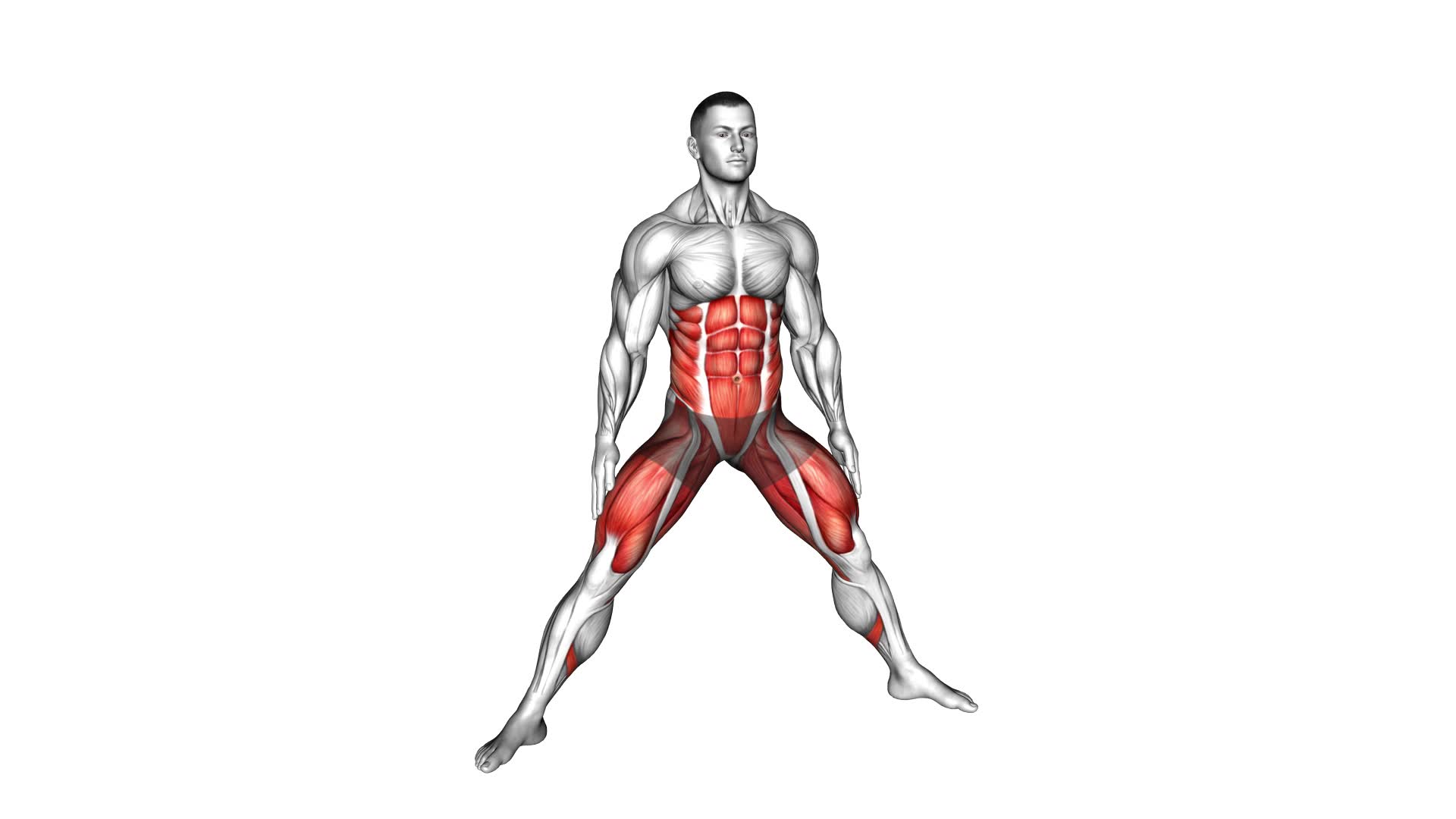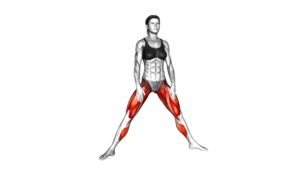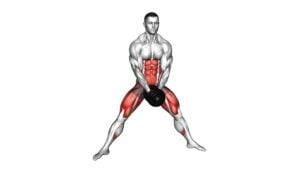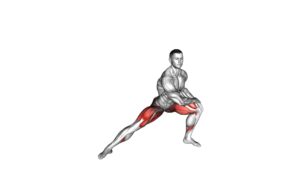Plyo Side Lunge Stretch (male) – Video Exercise Guide & Tips

Are you looking to amp up your lower body workout? Then the Plyo Side Lunge Stretch is for you!
Watch This Exercise Video
In this video exercise guide, we'll show you the proper form and technique to maximize the benefits of this dynamic stretch.
Say goodbye to common mistakes and hello to modifications and progressions that will challenge your muscles in all the right ways.
Get ready to incorporate the Plyo Side Lunge Stretch into your routine and take your fitness to the next level!
Key Takeaways
- Plyo Side Lunge Stretch improves flexibility and enhances lower body strength.
- It increases balance, stability, and range of motion in muscles and joints.
- Proper form and technique are crucial for achieving fitness goals and reducing injuries.
- Modifications and progressions can be made to suit individuals of different fitness levels.
Benefits of Plyo Side Lunge Stretch
You will experience three key benefits from incorporating the Plyo Side Lunge Stretch into your exercise routine.
The first benefit is that it helps to improve flexibility. Dynamic stretching, like the Plyo Side Lunge Stretch, helps to increase the range of motion in your muscles and joints. This can lead to better performance in activities that require flexibility, such as dancing or martial arts.
The second benefit is that it enhances lower body strength. By adding a plyometric element to the traditional side lunge stretch, you're engaging your muscles in a more dynamic way. This can help to build strength in your glutes, quads, and hamstrings.
The third benefit is that it improves balance and stability. The variations of the side lunge stretch, like adding a jump or reaching for your toes, challenge your body to maintain balance and stability. This can be particularly beneficial for athletes who need to have good balance for their sport.
Incorporating the Plyo Side Lunge Stretch into your exercise routine can provide you with these three key benefits: increased flexibility, enhanced lower body strength, and improved balance and stability.
Now let's discuss the equipment needed for the plyo side lunge stretch.
Equipment Needed for Plyo Side Lunge Stretch
To perform the Plyo Side Lunge Stretch, you'll need the following equipment:
- A flat, non-slip surface: Ensure that the area where you'll be performing the plyo side lunge stretch is free from any obstacles or hazards. This will provide a safe and stable environment for your workout.
- Comfortable workout attire: Wear clothing that allows for a full range of motion and provides proper support. Opt for breathable materials that wick away moisture to keep you comfortable during your workout.
- Athletic shoes: Choose a pair of shoes that offer good traction and stability. This will help you maintain balance and prevent any potential injuries while performing the plyo side lunge stretch.
- Optional equipment: While not necessary, you may choose to use additional equipment to enhance your workout. This can include resistance bands or dumbbells to add resistance and increase the intensity of the exercise.
By having the right equipment, you can ensure a safe and effective plyo side lunge stretch routine.
Remember to always listen to your body and consult with a fitness professional before starting any new exercise program.
Discussion ideas:
- Recommended equipment for plyo side lunge stretch
- Best variations of plyo side lunge stretch.
Proper Form and Technique for Plyo Side Lunge Stretch
To ensure proper form and technique for the Plyo Side Lunge Stretch, there are a few key points to keep in mind.
First, focus on the benefits of the stretch, such as improved flexibility and increased range of motion.
Second, be aware of common mistakes to avoid, such as rounding the back or letting the knees collapse inward.
Benefits of Stretch
The benefits of performing the Plyo Side Lunge Stretch with proper form and technique include increased flexibility and improved lower body strength. By incorporating this stretch into your routine, you can experience the following benefits:
- Improving flexibility:
- The Plyo Side Lunge Stretch targets muscles in your hips, groin, and inner thighs, helping to improve their flexibility.
- Increased flexibility can enhance your overall athletic performance and reduce the risk of muscle strains and injuries.
- Increasing range of motion:
- This stretch requires you to move through a deep lateral lunge position, which helps increase your range of motion in the hips.
- Improved range of motion can enhance your ability to perform movements in various sports and activities.
Incorporating the Plyo Side Lunge Stretch into your workouts can provide you with the flexibility and range of motion necessary to excel in your fitness goals while reducing the risk of injury.
Common Mistakes to Avoid
To properly execute the Plyo Side Lunge Stretch and avoid common mistakes, focus on maintaining proper form and technique.
One common mistake isn't fully engaging your core muscles during the exercise. It's essential to keep your core tight throughout the movement to ensure stability and prevent injury.
Another mistake to avoid isn't keeping your knees in line with your toes. Letting your knees collapse inward can put stress on the joints and increase the risk of injury.
Overcoming these challenges can be achieved by practicing the exercise slowly and gradually increasing the range of motion.
Additionally, if you find the Plyo Side Lunge Stretch too challenging, there are alternative exercises like static side lunges or lateral lunges that can help you improve flexibility and strength in a more manageable way.
Modifications for Beginners
Avoiding common mistakes in the Plyo Side Lunge Stretch and focusing on proper form and technique is crucial for beginners. To ensure you perform the exercise correctly and prevent injury, here are some modifications and progression tips:
- Beginner Modifications:
- Start with a shorter range of motion: Instead of lunging deep, take smaller steps sideways to reduce strain on your muscles and joints.
- Use a support: Hold onto a stable object, such as a chair or wall, for balance and stability while performing the exercise.
- Progression Tips:
- Increase the range of motion: Gradually work your way towards deeper lunges as your flexibility and strength improve.
- Add weights: Hold dumbbells or kettlebells in your hands to challenge your muscles and make the exercise more intense.
Remember to listen to your body and go at your own pace.
Common Mistakes to Avoid During Plyo Side Lunge Stretch
To ensure proper form during the Plyo Side Lunge Stretch, it's important to keep a few tips in mind.
First, make sure to maintain a straight back and engage your core throughout the movement. This will help prevent overstretching and potential injuries.
Additionally, be mindful of your knee position and avoid letting it extend past your toes to avoid unnecessary strain.
Proper Form Tips
For optimal results during the Plyo Side Lunge Stretch, focus on maintaining proper form throughout the exercise. Here are some proper form tips to help you get the most out of this stretch:
- Common Mistakes to Avoid:
- Avoid collapsing your chest or rounding your back. Keep your spine straight and engage your core to maintain stability.
- Don't let your knees go past your toes. Keep them aligned with your ankles to avoid unnecessary strain on your joints.
- Modifications for Beginners:
- If you're new to this exercise, start by performing a regular side lunge without the plyometric jump. This will help you get accustomed to the movement before adding the explosive element.
- You can also use a chair or wall for support if you have trouble balancing during the stretch.
By following these proper form tips, you can reduce the risk of injury and maximize the effectiveness of the Plyo Side Lunge Stretch.
Now, let's move on to the next section where we'll discuss how to avoid overstretching injuries.
Avoiding Overstretching Injuries
To prevent overstretching injuries during the Plyo Side Lunge Stretch, focus on maintaining proper form and avoiding common mistakes.
It's important to remember that stretching should never cause pain or discomfort. One common mistake to avoid is pushing yourself too hard, as this can lead to muscle strains or tears. Instead, start with gentle stretches and gradually increase your range of motion over time.
Another mistake isn't warming up properly before stretching. Warm up your muscles with some light cardio exercises to increase blood flow and prepare your body for stretching.
Additionally, don't bounce or jerk while stretching, as this can lead to injury. Remember to listen to your body and only stretch to a point where you feel a gentle pull.
Transitioning into the next section, let's explore modifications and progressions for the Plyo Side Lunge Stretch.
Modifications and Progressions for Plyo Side Lunge Stretch
You can modify and progress the Plyo Side Lunge Stretch to further challenge your lower body strength and flexibility. Here are some modifications and progressions you can try:
- Modifications:
- Reduce the depth of the lunge: If you find it difficult to perform the Plyo Side Lunge Stretch with a full range of motion, you can start by decreasing the depth of the lunge. This will allow you to gradually build up your strength and flexibility.
- Use a support: If you struggle with balance or have any stability issues, you can hold onto a sturdy object, such as a chair or wall, for support. This will help you maintain proper form and reduce the risk of injury.
- Progressions:
- Add weights: Once you have mastered the Plyo Side Lunge Stretch without any additional resistance, you can progress by adding weights. Holding dumbbells or using a weighted vest will increase the challenge on your muscles and enhance the effectiveness of the exercise.
- Increase the speed: To further challenge your lower body strength and power, you can perform the Plyo Side Lunge Stretch at a faster pace. This will require more explosive movements and improve your agility and coordination.
Remember to listen to your body and progress at a pace that feels comfortable for you. It's important to maintain proper form throughout the exercise to avoid any potential injuries.
Tips for Incorporating Plyo Side Lunge Stretch Into Your Workout Routine
To effectively incorporate the Plyo Side Lunge Stretch into your workout routine, consistently practice the exercise to improve your lower body strength and flexibility.
One way to incorporate this stretch is by including it in your warm-up routine. Before engaging in any intense physical activity, it's important to warm up your muscles to prevent injury. The Plyo Side Lunge Stretch is a dynamic exercise that can help warm up your lower body and prepare it for the workout ahead.
Another tip for incorporating this stretch into your routine is to gradually increase the intensity and duration of the exercise. Start with a few repetitions and slowly increase as your muscles become more accustomed to the movement. This will help improve your flexibility over time.
It is also important to focus on proper form while performing the Plyo Side Lunge Stretch. Make sure to keep your back straight, chest up, and knees aligned with your toes. This will ensure that you're targeting the correct muscles and maximizing the benefits of the stretch.
Frequently Asked Questions
How Many Repetitions Should I Do for the Plyo Side Lunge Stretch?
For the plyo side lunge stretch, it's important to focus on proper form. Start by standing with your feet hip-width apart, then step to the side and lower into a lunge position. Push off with your foot and jump to switch sides.
As for the number of repetitions, it depends on your fitness level and goals. Beginners may start with 10-12 reps per side, while more advanced individuals can aim for 15-20 reps.
Remember to listen to your body and adjust accordingly.
Can I Perform the Plyo Side Lunge Stretch if I Have Knee Pain?
If you have knee pain, it's important to listen to your body and modify exercises accordingly. The Plyo Side Lunge Stretch may not be suitable for you as it puts pressure on the knees.
However, there are alternative knee-friendly stretches that can provide similar benefits. Some options include seated hamstring stretches, standing quad stretches, and gentle calf stretches.
These stretches can help improve flexibility and reduce pain without straining your knees.
Can the Plyo Side Lunge Stretch Help Improve My Flexibility?
Improving your flexibility is a common goal for many people. One exercise that can help with this is the plyo side lunge stretch.
By incorporating this stretch into your routine, you can increase your range of motion and improve flexibility in your hips, groin, and inner thighs.
The plyometric aspect of this exercise adds an extra challenge, making it even more beneficial for building strength and power.
Is It Better to Perform the Plyo Side Lunge Stretch Before or After My Workout?
Performing the plyo side lunge stretch before or after your workout has different benefits.
Pre-workout, it can help to warm up your muscles, increase blood flow, and prepare your body for exercise.
On the other hand, performing it post-workout can aid in cooling down your body, reducing muscle soreness, and improving flexibility.
Can I Still Benefit From the Plyo Side Lunge Stretch if I Have Limited Space?
If you have limited space, you can still benefit from the plyo side lunge stretch. This stretch is great for tight muscles and can help improve flexibility and range of motion.
To modify it for limited space, you can simply reduce the size of your lunges or take smaller steps. Remember to keep proper form and engage your core for maximum effectiveness.
Stretching regularly will help you see the benefits in no time.
Conclusion
Incorporating the Plyo Side Lunge Stretch into your workout routine can provide numerous benefits, including improved flexibility, increased lower body strength, and enhanced balance.
By following proper form and technique, avoiding common mistakes, and making modifications if needed, you can safely and effectively perform this exercise.
Remember to consult with a fitness professional before starting any new exercise program to ensure it's suitable for your individual needs and goals.

Author
Years ago, the spark of my life’s passion ignited in my mind the moment I stepped into the local gym for the first time. The inaugural bead of perspiration, the initial endeavor, the very first surge of endorphins, and a sense of pride that washed over me post-workout marked the beginning of my deep-seated interest in strength sports, fitness, and sports nutrition. This very curiosity blossomed rapidly into a profound fascination, propelling me to earn a Master’s degree in Physical Education from the Academy of Physical Education in Krakow, followed by a Sports Manager diploma from the Jagiellonian University. My journey of growth led me to gain more specialized qualifications, such as being a certified personal trainer with a focus on sports dietetics, a lifeguard, and an instructor for wellness and corrective gymnastics. Theoretical knowledge paired seamlessly with practical experience, reinforcing my belief that the transformation of individuals under my guidance was also a reflection of my personal growth. This belief holds true even today. Each day, I strive to push the boundaries and explore new realms. These realms gently elevate me to greater heights. The unique combination of passion for my field and the continuous quest for growth fuels my drive to break new ground.







